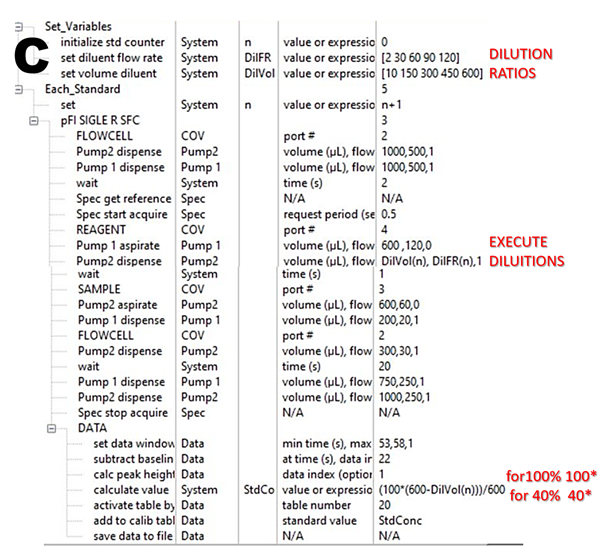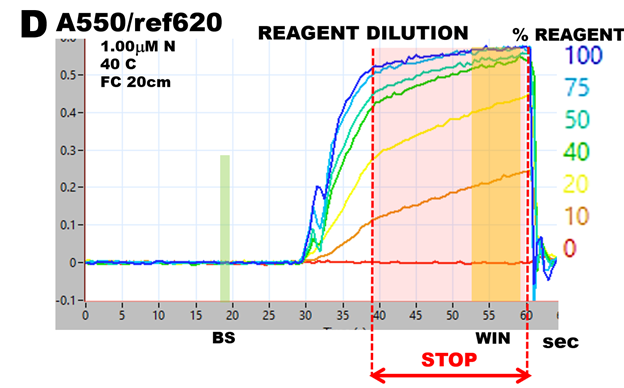3.2.5.5. Optimization of Assay by Automated Reagent Dilution
Sensitivity of reagent-based assay is optimized when calibration data fit linear regression, and the slope of calibration line is maximized. This is achieved when reaction reaches, or is close to, equilibrium when the yield of monitored species is maximized. To operate at a useful sampling frequency, it is therefore desirable to accelerate reaction rate by increasing the temperature (for endothermic reactions) and concentration of reagent(s). While it is the current practice to investigate influence of temperature in systematic way, influence of reagent concentration on calibration data is seldom reported because obtaining it is labor-intensive.
It is, however, easy to determine influence of reagent concentration on the yield of monitored species, at conditions equal to actual assay, by simple modification of automated assay protocol. Thus for spectrophotometric determination of nitrite by Griess reaction (Section 3.2.5.), the assay protocol (A) is modified to become a reagent optimization protocol (B) by:
- Aspirating Gries reagent through sample port (#4)
- Aspirating nitrite (1000 nM N) through reagent port (#3)
- By adjusting the flowrates in the second step to obtain the same nitrite/reagent mixing ratio as in the assay protocol

The corresponding software program (C) will execute reagent dilution in five steps starting with the undiluted 100% Griess reagent stock solution, followed by 75%, 50%, 25%, and 0% reagent prepared by automated dilution with carrier stream of DI water. To cover a wider range of dilutions, the protocol was run two times: first in the range of 100% to 0% reagent concentrations by aspirating through port #4 Griess reagent stock solution and inserting value 100* into the script (C bottom right). To cover range 40% to 0% , stock Gries reagent was manually diluted by DI water to 40% and aspirated through port #4, and value 40* was inserted into the script. The same nitrite solution (1000 nM N) was used.

Both experiments and recorded responses were plotted in the same figure (D). It is seen that reaction rate increases with concentration of reagent, but reaction rate curves become identical only for 75% and 100% of stock Griess reagent. This is confirmed by plotting absorbance values collected within WIN period (E).


Thus, by taking the mean absorbance value of undiluted reagent (100%) as maximum achievable value, the absorbance for 75% diluted reagent is only 1% lower while for 50% diluted reagent is 4% lower.

However, calibrations obtained with Griess reagent in range 100% to 25% with 1000 nM N standard solutions (Protocol 3.2.5.2.A.) reveal that reagent dilution has larger influence on the slope of calibration line.
Therefore, for determination of nitrite at nanomolar level, as found in sea and other waters, the 100% Griess reagent should be used because minor changes in its concentration, due to preparation or decomposition during storage, will not influence sensitivity of determination. Therefore the stock solution of Griess reagent should not be diluted more than 50%.
Value of this simple experiment, applicable to any reagent-based assay is, that the stop-flow measurement provides information on the yield of chemical reactions, while with (traditional) continuous flow this information is not available, and optimization is done manually by trial and error.
